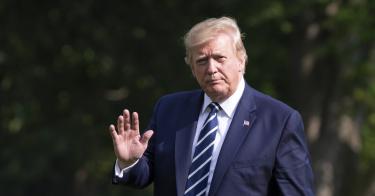President Donald Trump’s proposed budget for fiscal 2021 prioritizes immigration enforcement by increasing resources for Customs and Border Protection, Immigration and Customs Enforcement, and the Justice Department.
The budget also combats “sanctuary” policies through proposed statutory language that conditions certain grants on recipients cooperating with immigration enforcement activities and requests.
The budget also calls explicitly for using immigration operations as deficit-reduction tools.
The fiscal 2021 spending blueprint is clear that national security and immigration are express constitutional functions of the federal government.
“Border security is national security” is the opening line of the Department of Homeland Security’s budget-in-brief funding priorities.
First, the border wall: The budget seeks nearly $2 billion for construction of about 82 miles of new border wall systems—the wall, technology, lights, access roads—in fiscal 2021.
That’s in addition to the $18 billion provided for wall systems from fiscal years 2017 through 2020 (including the Defense Department’s military construction funds and the Treasury Department’s criminal asset-forfeiture dollars). All of this will provide 1,000 miles of wall, some replacement sections and some not.
The $2 billion is less than the $5 billion sought by the president last year, because the administration is assessing where else new wall is needed.
The budget also seeks $161.2 million for hiring, training, and equipping 750 additional Border Patrol agents and 126 necessary support personnel. The budget would create a new position for Border Patrol processing coordinators to receive and process incoming detainees, manage personal property, perform welfare checks, transport detainees, and coordinate logistical and travel requirements.
>>>Trump Budget Cuts Size of Federal Government, but Bolder Reforms Needed
Last year, during the crisis on the southwest border, too many Border Patrol agents and field operations officers were pulled off their respective lines to perform those functions. For that reason, the budget seeks $20 million to hire 300 coordinators so the agents can remain on the line.
To supplement Border Patrol technology, the budget requests $28 million to construct 30 more surveillance towers. With this funding, Customs and Border Protection intends to deploy a total of 200 such autonomous towers, which provide computerized surveillance in areas that are difficult for agents to patrol.
Beyond the border, the administration also strongly supports interior immigration enforcement with a $1.8 billion increase for Immigration and Customs Enforcement, including:
- $3.1 billion for 60,000 detention beds, 5,000 of them for family units. The beds would help discourage would-be immigrant families from illegally entering the U.S. by applying consequences, obviating the need for “catch and release,” an undesirable tactic used during the border crisis and past administrations.
- $543.6 million for law enforcement hiring, including an additional 2,844 officers and 1,792 support personnel. The support employees include 293 more lawyers and 81 related staff for the increased workload associated with hiring immigration judges and expanding courtrooms to address a backlog.
- $603.5 million for transportation and removal costs, which include air charter flights, commercial flights, and ground transportation contracts.
- $126 million for the successful Migrant Protection Protocol, which includes operations at immigration hearing facilities and transportation of migrants from points of entry to those facilities or other designated locations.
- $353.9 million for the Alternatives to Detention Program to monitor 120,000 participants. Instead of detention, the program supervises aliens through a combination of home or office visits, alert response, court tracking, and/or technology.
The president’s budget proposes $883 million for the Justice Department’s Executive Office for Immigration Review, a 31% increase over fiscal 2020.
To tackle the unreasonably large backlog of cases, the budget provides funding for an additional 100 immigration judge teams and for the office’s modernization of information technology.
The Trump administration has become fed up with the variety of tactics used by liberal states and localities to thwart immigration enforcement. These include releasing criminal aliens onto the streets after refusing to honor an ICE detainer; prohibiting ICE from using an international airport for alien removals; and refusing to share information from motor vehicle agencies with immigration enforcement agencies.
To remind states and localities that immigration is a federal function and that states and localities receive considerable federal funding in relation to homeland security, the budget proposes statutory language that would:
(1) clarify that a federal, state, or local law, entity, or official may not prohibit or restrict compliance with a civil immigration detainer.
(2) explicitly authorize the Department of Homeland Security and the Justice Department to condition grants and cooperative agreements on the recipient’s cooperation with federal immigration enforcement activities and requests.
Finally, Trump’s budget proposal includes two immigration-related deficit-reduction proposals:
- A 10% surcharge to immigration filing fees. The administration explains that those immigration applicants who relocate to the United States benefit significantly from opportunities in America. The surcharge would raise an estimated $4 billion over 10 years.
- A 35% increase in all civil and criminal worksite enforcement penalties assessed against employers who violate the law by unlawfully employing aliens. The budget doesn’t estimate the additional revenue from the increased penalties, but says the revenue would be directed to deficit reduction.
The Democrat-led House will oppose several of these budget items related to enforcing immigration law, particularly the ICE increases, more detention beds, and anti-sanctuary language.
Because we are in a presidential election year, the debate over funding efforts to curb illegal immigration will be hyperpolitical in Congress.
We’re unlikely to see a final Department of Homeland Security appropriations bill before the November election, however. Congress is in the practice of passing continuing resolutions to get past any political events, and the election is the biggest political event of them all.
This piece originally appeared in The Daily Signal




